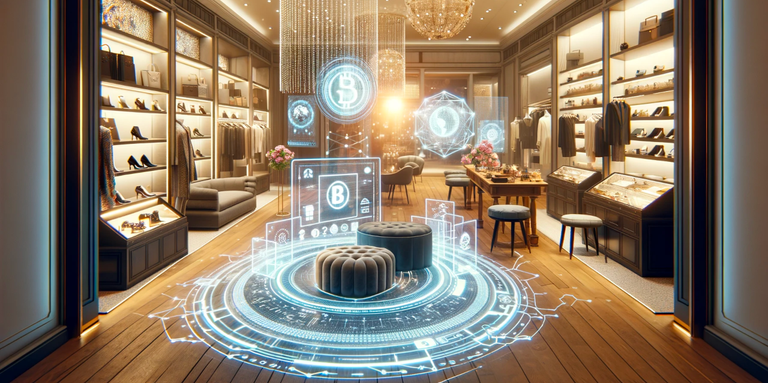The luxury goods industry is undergoing a pivotal transformation, driven by the rapid embrace of digitalization. This shift introduces both opportunities and challenges, particularly in combating the rise of counterfeit goods and clarifying the provenance of luxury items. In 2020, counterfeit and pirated goods represented up to 3.3% of global trade, a significant concern for luxury brands seeking to preserve their integrity and value.
Blockchain technology emerges as a key player in addressing these issues, offering a path towards decentralization, immutability, and transparency. With blockchain, every luxury item can have a digital ledger that tracks its entire lifecycle, from creation to consumer, ensuring authenticity and traceability.
Colle stands at the forefront of this transformation, leveraging blockchain to redefine the concept of luxury ownership in the digital age. By prioritizing transparency and trust, Colle aims to reshape how consumers interact with luxury goods, promising a future where authenticity is unquestionable and the luxury experience is enhanced by digital innovation. This sets the stage for our exploration of Colle's role in this evolving landscape, highlighting the potential of technology to revolutionize the luxury goods market.

The Role of Blockchain in Luxury
Blockchain technology, at its simplest, is a digital ledger that securely records transactions across many computers. This ensures that once a transaction is recorded, it cannot be altered, making each entry verifiable and permanent. For the luxury goods market, this offers a revolutionary approach to tackling two of its most significant challenges: authenticity and provenance.
Authenticity in luxury goods isn't just about ensuring an item is genuine; it's about building consumer trust. Counterfeit products not only harm brand reputation but also erode consumer confidence. Blockchain's transparent nature allows for the creation of a digital certificate for each item, verifying its authenticity from the moment it's created.
Provenance, or the history of ownership, is equally crucial in the luxury market. Consumers want to know where their items come from, who has owned them, and whether they're ethically sourced. Blockchain provides a tamper-proof history of an item's journey, from its creation to its current owner, ensuring transparency and accountability.
By embedding blockchain into their operations, luxury brands and marketplaces can significantly enhance the value they offer to consumers, ensuring every piece's story is as authentic and luxurious as the item itself. This not only strengthens consumer trust but also elevates the overall brand experience in the luxury market.

Bridging Traditional and Digital in Luxury Markets
The emerging digital landscape for luxury goods presents a unique opportunity to enhance how we define, experience, and validate luxury. However, this digital evolution must conscientiously accommodate traditional luxury buyers, a demographic deeply rooted in the tactile and personal aspects of luxury shopping. The challenge isn't merely technological; it's cultural and experiential, necessitating a balance between innovation and familiarity.
Traditional luxury buyers have cultivated expectations around the purchasing experience that digital platforms need to respect and reflect. The allure of luxury shopping often lies in the experience as much as in the item itself — the personalized service, the ambiance of exclusivity, and the assurance of authenticity. Transitioning these experiences into a digital format requires not just technological solutions but an understanding of the values that underpin traditional luxury markets.
One of the primary hurdles in integrating blockchain and digital technologies into the luxury market is the complexity and novelty of these technologies. Web3 and blockchain offer robust solutions for authenticity, provenance, and security but often at the expense of user simplicity. Finding the right balance between a straightforward, accessible user experience and maintaining the high security and transparency standards blockchain provides is crucial. It's about ensuring that non-web3 natives can navigate and trust the digital platform as readily as they would a traditional luxury boutique.
The responsibility falls on the builders within the luxury digital space to facilitate this transition. Onboarding traditional users is not just about translating physical experiences into digital equivalents. It's about educating and guiding users through the new digital landscape, ensuring they understand and appreciate the added value of blockchain verification without feeling overwhelmed by the technology.

Diverse Solutions
In the evolving landscape of luxury digital transformation, distinct approaches are paving the way for a more authenticated and transparent market.
Some luxury watch brands, such as Breitling, have taken a notable stride by embedding blockchain technology directly into their luxury watches. By issuing a digital passport for every timepiece, they offer a system where owners can verify authenticity and trace the item's history. This initiative not only combats counterfeiting but also fosters a new level of consumer engagement and trust in the brand's legacy.
Other companies, such as IYK, are innovating at the intersection of physical and digital worlds by utilizing NFC technology to power phygitals — physical goods with embedded digital identities. Collaborating closely with brands, IYK transforms traditional luxury items into digitally enhanced assets, enabling verifiable authenticity and interactive experiences directly tied to the physical product.
Marketplaces such as Colle, on the other hand, are broadening the scope by developing a generalized solution applicable to a multitude of brands and product categories, which would support both traditional luxury goods, and new-age phygital goods. Colle's blockchain-powered marketplace not only ensures the verification of luxury items' authenticity but also facilitates secure and transparent transactions through on-chain escrows. Colle's platform is a testament to the potential of blockchain in creating a unified space where verified luxury goods can be traded with confidence, catering to a diverse array of consumers and collectors.
The efforts of Breitling, IYK, and Colle underscore the luxury sector's move towards digital assurance and innovation. Each player, in their way, contributes to a future where the authenticity, provenance, and ownership of luxury goods are indisputable and secure. These companies are illustrating the diverse strategies being employed to harness technology for enhancing the luxury experience.

As the luxury market continues to navigate the digital realm, these pioneering moves signal a broader trend of adaptation and innovation. Through tailored solutions, phygital innovations, and modernized marketplaces, the industry is setting new standards for trust, transparency, and consumer engagement. The ultimate goal shared by these initiatives is to enrich the luxury buying experience in the digital age, ensuring that every purchase is as authentic and valuable as its physical counterpart.
As an engineer at Colle, I'm extending an exclusive invite to the Hive community to join Colle :)
Colle is a invite only luxury watch marketplace operating on the Polygon network. Signing up is easy via email, MetaMask, or WalletConnect.
If you are interested in checking us out, you are welcome to join via this invitation link